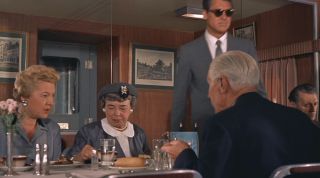The MacGuffin: News and Comment (23/Aug/2008)
(c) Ken Mogg (2008)
August 23
Left hanging last time was Yves Lavandier's criticism of North by Northwest, that there's 'something a little artificial about' it - a strange criticism indeed. Someone wrote to me, '[does this mean] that the viewer is being coddled into not taking [the film] seriously[?] Tell that to [artists like] Mark Twain, Voltaire, Will Rogers, Michael Moore ...'. Lavandier has an excellent section on a spectator's 'needs', which he says are threefold: (1) emotion, (2) meaning, and (3) distraction (pp. 530-31). By the latter, he means 'a form of entertainment that diverts a person's attention from all the cares that assail him in his everyday life. ... However, greater distraction is obtained when there is more conflict. ... Distraction enables the spectator to take leave of himself, a state of mind that can be very restful [and even growthful].' Well, maybe, but there is ample conflict in North by Northwest, and as I suggested last time, practically every frame is a joy' - to the sophisticated viewer. (It is the faux sophisticated who may miss out, prompting critic Robin Wood to once write, 'Hitchcock is [sometimes] too sophisticated for the sophisticated'!) But let's just talk a little more this week about the joys of North by Northwest, both in tone and style. For example, has anyone noticed the dreamy, almost Groundhog Day-like, effect after the credits end, when we return to the same moment (and the same people) we had seen minutes before, a shot of workers pouring out of a New York city building? But this time, as we penetrate inside the building, we are gratified to spot Roger (Cary Grant) emerging from a lift, dictating in double-quick time to his secretary. He, at least, seems not just a 'figure in a landscape' - an impression which, like Roger himself, will be severely tested by ensuing events ... I noticed this moment because I wanted to check on how the in-between shots (during the credits) of workers pouring out of buildings and down subways, like a collective tidal wave, have been deliberately bleached to suggest those people's tiredness and depletion of 'life' - I claimed last time that North by Northwest is 'about "life" versus "death" in nearly every one of its frames'. Similarly, on the train, Roger's fellow passengers are generally made to appear respectable but drab and ageing and perhaps just a little smug, as in the frame-capture below. (Even Jesslyn Fax's piece of business a moment before - sometimes mistaken as a cameo by Hitchcock in drag! - as a stout lady who 'humphs' at two ticket-inspectors, fits this general pattern!) Of course, in the shot shown here we are being prepared, too, for the moment that follows in which we come upon a far from ageing Eve (Eva Marie Saint) at another table, smiling invitingly at Roger! Nonetheless, the general effect in the first two-thirds of the film is of a man - Roger - trapped in a deliberately-designed (by the filmmakers) artificial or deadly world, from which he must extricate himself by his own exertions. The effect, indeed, is positively surreal and Kafkaesque. How 'right' it is that those statues of American Presidents at Mount Rushmore should appear to look down superciliously upon all those who pass below them. These stone figures are 'idealised' in the philosophical sense, purely conceptual, not real. In a throwaway remark in his perceptive 'The Dark Side of Genius' (p. 333 of the 1983 British edition), Donald Spoto reveals that Hitchcock's original inspiration to make North by Northwest was his idea to have someone on Mount Rushmore cling from one of Lincoln's eyebrows (not hide in his nostril and have a sneezing fit, as the mischievous Hitch later gave out!). That general idea (the superciliousness), at least, is nicely realised in the finished film, accounting for Roger's remark, 'I don't like the way Teddy Roosevelt is looking at me!' (Thanks to SR for input to this week's entry.)
This material is copyright of Ken Mogg and the Hitchcock Scholars/'MacGuffin' website (home page) and is archived with the permission of the copyright holder. |

